Rachel Knowles's Blog, page 14
May 26, 2016
The Austen-Edgeworth connection
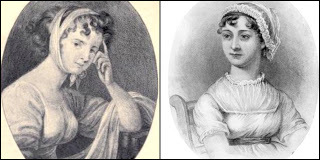 Two of the women I am researching for my book—What Regency Women Did For Us—were novelists. One is undoubtedly today’s best known Regency novelist – Jane Austen; the other is the lesser known Maria Edgeworth. You might be surprised to hear that it was not always that way round. Back in their day, it was Maria Edgeworth who was the more famous of the two and the more commercially successful. Indeed, she probably earned more money from her novels during her lifetime than any of her contemporaries.......
Two of the women I am researching for my book—What Regency Women Did For Us—were novelists. One is undoubtedly today’s best known Regency novelist – Jane Austen; the other is the lesser known Maria Edgeworth. You might be surprised to hear that it was not always that way round. Back in their day, it was Maria Edgeworth who was the more famous of the two and the more commercially successful. Indeed, she probably earned more money from her novels during her lifetime than any of her contemporaries.......
Published on May 26, 2016 05:39
May 11, 2016
1816: the year without a summer
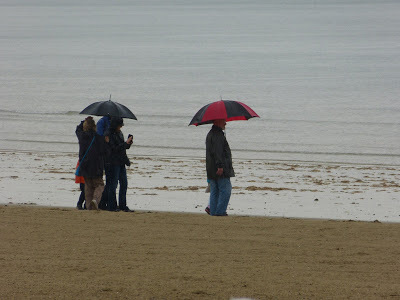 We might joke that you can blink and miss the English summer, but what if it really was cancelled this year?
We might joke that you can blink and miss the English summer, but what if it really was cancelled this year?Two hundred years ago, in 1816, people in England and much of Europe were bemused by a summer that was noticeably colder and wetter than usual. This was bad news for a society that depended largely on a good harvest for its wellbeing. It was even worse news for nations ravaged by the recent Napoleonic wars...
Published on May 11, 2016 08:21
April 20, 2016
Maria Merian's Butterflies - 2016 exhibition at the Queen's Gallery
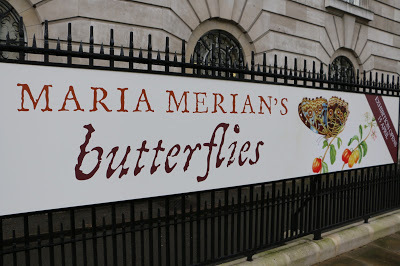 I recently visited the Queen’s Gallery, Buckingham Palace, London, for a curator-led tour of the new exhibitions: Scottish Artists 1750-1900: From Caledonia to the Continent and Maria Merian’s Butterflies. This post is about the second exhibition: Maria Merian’s Butterflies.
I recently visited the Queen’s Gallery, Buckingham Palace, London, for a curator-led tour of the new exhibitions: Scottish Artists 1750-1900: From Caledonia to the Continent and Maria Merian’s Butterflies. This post is about the second exhibition: Maria Merian’s Butterflies.The amazing Maria Merian (1647-1717)
I confess that I wasn’t at all sure that I would be interested in Maria Merian’s work. After all, she was born aroun...
Published on April 20, 2016 03:37
April 18, 2016
Scottish Artists 1750-1900 - 2016 exhibition at the Queen's Gallery
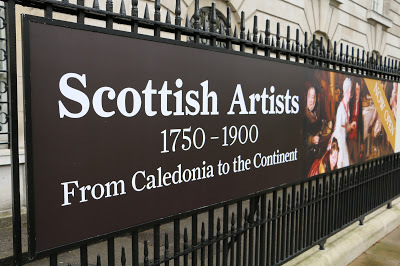 Last Friday, I was delighted to visit the Queen’s Gallery, Buckingham Palace, London, for a bloggers’ breakfast and curator-led tour of the new exhibitions—Scottish Artists 1750-1900: From Caledonia to the Continent and Maria Merian’s Butterflies. In this post, I will look at the first of these exhibitions—Scottish Artists.
Last Friday, I was delighted to visit the Queen’s Gallery, Buckingham Palace, London, for a bloggers’ breakfast and curator-led tour of the new exhibitions—Scottish Artists 1750-1900: From Caledonia to the Continent and Maria Merian’s Butterflies. In this post, I will look at the first of these exhibitions—Scottish Artists. The best collection of Scottish Art outside of Scotland
The Scottish Artists exhibition is a sumptuous display of Scottish art from the Georgian and Victorian periods. But...
Published on April 18, 2016 10:46
April 13, 2016
A Regency History guide to Belinda by Maria Edgeworth
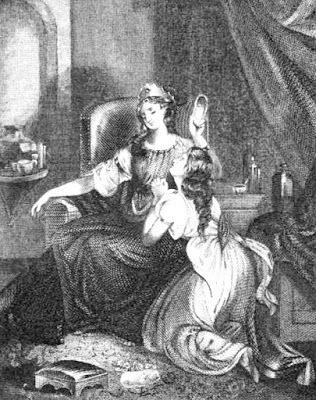 A moral tale
A moral taleBelinda is a novel by Maria Edgeworth, first published in 1801 in three volumes. However, the author was clearly anxious that her work was not lumped together with the trashy novels of her day and in a note at the beginning of the book, she wrote:
“The following work is offered to the public as a Moral Tale – the author not wishing to acknowledge a Novel. Were all novels like those of Madame de Crousaz, Mr...
Published on April 13, 2016 06:24
March 31, 2016
Regency medicine - the invention of the stethoscope
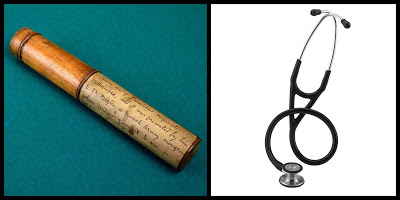 Left: Laennec's original stethoscope Science Museum, London
Left: Laennec's original stethoscope Science Museum, LondonRight: A modern Littmann stethoscope This year, 2016, is the 200th anniversary of the invention of the stethoscope. As with so many innovations, the stethoscope was not immediately welcomed by many Regency physicians. But then, so much of the medical knowledge we now take for granted was a mystery to doctors in the early nineteenth century.
The Georgian killer disease: consumption
Consumption, or tuberculosis as we now know it, killed...
Published on March 31, 2016 10:04
March 15, 2016
Regency opera dresses
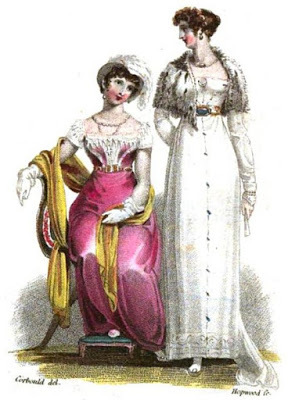 Opera dresses from The Mirror of the Graces (1811)Here is the final post from The Mirror of the Graces depicting fashion at the beginning of the Regency. The other posts are: morning dresses, promenade dresses and evening dresses. This post looks at opera dresses.
Opera dresses from The Mirror of the Graces (1811)Here is the final post from The Mirror of the Graces depicting fashion at the beginning of the Regency. The other posts are: morning dresses, promenade dresses and evening dresses. This post looks at opera dresses.Lady in pink
“The fourth plate represents two females in opera or full dress. First figure attired in a round robe, with a demi-train of pink imperial gauze, worn over a white satin slip, ornamented round the bosom, back, and shoulder...
Published on March 15, 2016 05:15
February 26, 2016
The original steamy Georgian romance
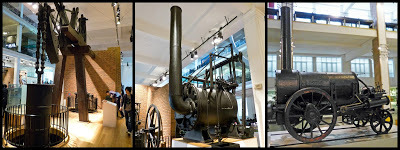 Steam engines in the Science Museum, LondonThe first commercial steam engine was developed in 1712, just a couple of years before the Georgian era began. In the century that followed, many Georgians fell in love with steam power because of the benefits it brought to them, to their businesses and to the wider economy. While steam power doesn’t feature in many Georgian and Regency romances, both contemporary and written at the time, it was working noisily in the background to power the industri...
Steam engines in the Science Museum, LondonThe first commercial steam engine was developed in 1712, just a couple of years before the Georgian era began. In the century that followed, many Georgians fell in love with steam power because of the benefits it brought to them, to their businesses and to the wider economy. While steam power doesn’t feature in many Georgian and Regency romances, both contemporary and written at the time, it was working noisily in the background to power the industri...
Published on February 26, 2016 08:19
February 6, 2016
Carlton House - a Regency History guide
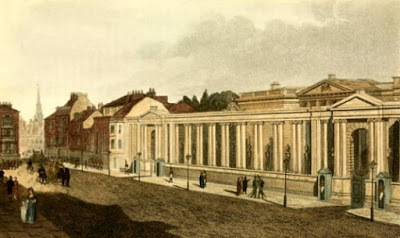 What was Carlton House?
What was Carlton House?Carlton House was the London residence of George IV from 1783 to 1826. He spent an exorbitant amount of money remodelling and refurnishing it, but after becoming King, he decided it was inadequate for his needs. George moved out in 1826 and Carlton House was demolished to make way for an exclusive housing development which still stands on Carlton House Terrace today.
History
Carlton House derived its name from...
Published on February 06, 2016 11:48
January 22, 2016
Elizabeth Fry - prison reformer (1780-1845)
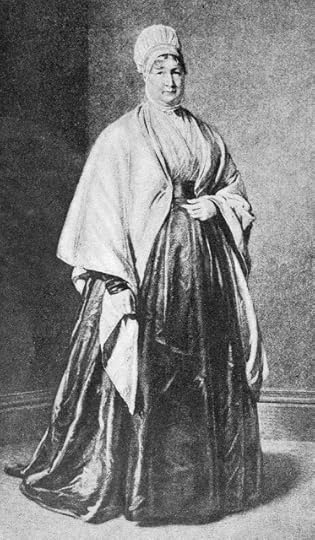
Elizabeth Fry (née Gurney) (21 May 1780 – 13 October 1845) was a Quaker minister famous for her pioneering work in prison reform. She is currently depicted on the British five pound note.
An unhappy childhood
Elizabeth Gurney was born in Norwich, Norfolk, on 21 May 1780, one of the 12 children of John Gurney and Catherine Bell. Both her parents were from families that belonged to the Religious Society of Friends, more...
Published on January 22, 2016 03:49



